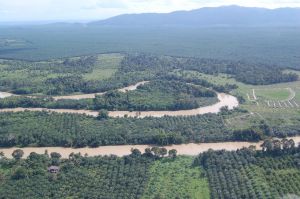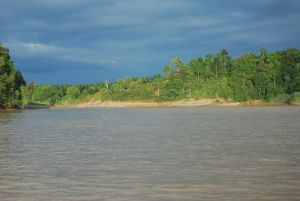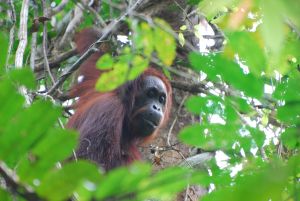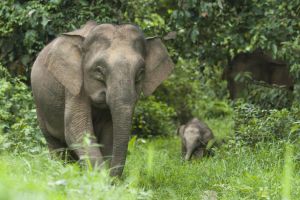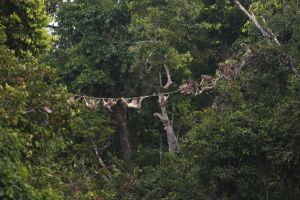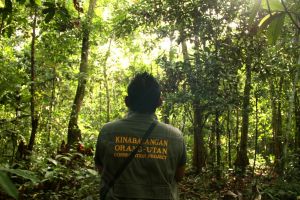Lower Kinabatangan Wildlife Sanctuary
Asia > Malaysia > Lower Kinabatangan Wildlife Sanctuary
Français | Português | Español | Bahasa Indonesia | Melayu
Summary
- Northeast Bornean orangutans (Pongo pygmaeus morio) are present in Lower Kinabatangan Wildlife Sanctuary.
- It has been estimated that 785 (414-1467) individuals occur in the site.
- The orangutan population trend is decreasing.
- The site has a total size of 270 km².
- Key threats to orangutans are logging and clearing land for oil palm plantations, and hunting.
- Conservation activities have focused on helping orangutans survive in fragmented forests by installing bridges, and running research activities and monitoring the population.
Site characteristics
The Lower Kinabatangan Wildlife Sanctuary (LKWS) is an important floodplain in the state of Sabah, in northern Malaysia. Sungai Kinabatangan, Sabah's largest and longest river (560 km), runs through this floodplain and floods seasonally (BirdLife International 2021). The catchment area of the river is about 1,680,000 ha, covering almost 23% of the total land area in Sabah (BirdLife International 2021). In spite of the intense exploitation of natural resources that has resulted if forest degradation and fragmentation, Kibatangan remains a biodiversity hotspot, harboring a remarkable diversity of wildlife; in addition to orangutans, the area is also home to proboscis monkeys, Bornean gibbons, Bornean elephants, cloud leopards, sun bears and several bird species, including several globally threatened waterbirds, such as Storm's Stork, Ciconia stormi (HUTAN 2019, BirdLife International 2021). In 2002 the government of Sabah gazetted 27,000 ha of highly disturbed forests as the LKWS (Ancrenaz 2004).
Table 1. Basic site information for Lower Kinabatangan Wildlife Sanctuary
| Species | 'Pongo pygmaeus morio |
| Area | 270 km² |
| Coordinates | Lat: 5.490476 , Lon: 118.148216 |
| Type of site | Protected area (Wildlife Sanctuary) |
| Habitat types | Subtropical/tropical swamp forest, Subtropical/tropical moist lowland forest, Subtropical/tropical heavily degraded former forest, Agricultural land |
| Type of governance |
IUCN habitat categories Site designations
Ape status
In the early 2000s, the population in Kinabatangan was 1,125 individuals (CI: 691-1,807), with an estimate of 670 individuals for the then-proposed Lower Kinabatangan Wildlife Sanctuary (Ancrenaz 2018). Compared to that estimate, the 2006-2007 surveys revealed a 28% decline in the population, and a further decline was revealed by a 2015 survey which estimated 785 (CI: 414-1,467) (Ancrenaz 2018).
Table 2. Ape population estimates reported for Lower Kinabatangan Wildlife Sanctuary
| Species | Year | Occurrence | Encounter or vistation rate (nests/km; ind/day) | Density estimate [ind./ km²] (95% CI) | Abundance estimate (95% CI) | Survey area | Sampling method | Analytical framework | Source | Comments | A.P.E.S. database ID |
|---|---|---|---|---|---|---|---|---|---|---|---|
| Pongo pygmaeus morio | 2002-2003 | 1.5-7.37 | 0.7-6.0 | 1,125 (691-1807) | Kinabatangan and surrounding forest fragments | Aerial (drones/plane/helicopter), Line transects | Ancrenaz et al. 2004 | ||||
| Pongo pygmaeus morio | 2006-2007 | 812 (425-1,418) | Lower Kinabatangan Wildlife Sanctuary and surrounding forest fragments | Aerial (drones/plane/helicopter), Line transects | Ancrenaz 2018 | ||||||
| Pongo pygmaeus morio | 2015 | 785 (414-1467) | Lower Kinabatangan Wildlife Sanctuary | Aerial (drones/plane/helicopter), Line transects | Ancrenaz 2018 |
Threats
Table 3. Threats to apes reported for Lower Kinabatangan Wildlife Sanctuary
| Category | Specific threats | Threat level | Description | Year of threat |
|---|---|---|---|---|
| 10 Geological events | Absent | |||
| 12 Other threat | Absent | |||
| 2 Agriculture & aquaculture | 2.1 Annual & perennial non-timber crops | High (more than 70% of population affected) | Habitat loss due to conversion of forest to oil palm plantations (Ancrenaz 2018). | Ongoing (2018) |
| 5 Biological resource use | 5.1 Hunting & collecting terrestrial animals | High (more than 70% of population affected) | Signs of hunting have been found at the site, such as cartridges, snares and traps (Ancrenaz 2018). | Ongoing (2018) |
| 5 Biological resource use | 5.3 Logging & wood harvesting | High (more than 70% of population affected) | Logging and clearing land for oil palm plantations (Ancrenaz 2018). | Ongoing (2018) |
| 9 Pollution | 9.3 Agricultural & forestry effluents | Present (unknown severity) | Pollution in the Sungai Kinabatangan catchment area from palm oil mills, pesticides, fertilizers and sediment from plantations, sediment from logging activities and sewage and refuse from villages along the river (BirdLife International 2021). | Ongoing (2021) |
| 1 Residential & commercial development | Unknown | |||
| 3 Energy production & mining | Unknown | |||
| 4 Transportation & service corridors | Unknown | |||
| 6 Human intrusions & disturbance | Unknown | |||
| 7 Natural system modifications | Unknown | |||
| 8 Invasive & other problematic species, genes & diseases | Unknown | |||
| 11 Climate change & severe weather | Unknown |
Conservation activities
In 1998, the NGO called HUTAN established the Kinabatangan Orang-utan Conservation Programme with support from Sabah's Wildlife Department. Research by HUTAN has shown that orangutans can thrive in highly disturbed and logged forests. In areas where hunting is not an issue, they can use the mixed forest/oil palm matrix as long as they have forest corridors (HUTAN 2019). It is therefore crucial to design orangutan conservation strategies at the landscape level that can incorporate existing oil palm plantations with the network of protected forest (HUTAN 2019).
Table 4. Conservation activities reported for Lower Kinabatangan Wildlife Sanctuary
| Category | Specific activity | Description | Implementing organization(s) | Year of activity |
|---|---|---|---|---|
| 1 Development impact mitigation | 1.9 Install green bridges (overpasses) or canopy bridges over transportation or service corridors | As part of the Kinabatangan Orang-utan Conservation Programme of HUTAN, orangutan bridges started to be installed in the early 2000s to address the issue of habitat fragmentation. This allows venturing males and adolescents to ensure proper gene flow between sub-populations (HUTAN 2019). | Ongoing (2019) | |
| 2 Counter-wildlife crime | 2.1 Implement road blocks to inspect cars for illegal ape bushmeat | Law enforcement activities include roadblocks to spot-check for poaching (HUTAN). | Ongoing (2021) | |
| 2 Counter-wildlife crime | 2.3 Conduct regular anti-poaching patrols | Since 2002, groups of people from the Kinabatangan community are appointed to become “Honorary Wildlife Wardens”. The Wardens are civilians who are given the same legal powers as rangers from the Sabah Wildlife Department to conserve and manage the natural resources, and to apprehend offenders when necessary. Enforcement activities primarily involve regular patrols by boat, car, and on foot. Patrols are conducted throughout the year and typically consist of two or three Wardens (HUTAN). | Ongoing (2021) | |
| 2 Counter-wildlife crime | 2.11 Implement monitoring surveillance strategies (e.g., SMART) or use monitoring data to improve effectiveness of patrols | Biomonitoring and research applied conservation and management (HUTAN). | Ongoing (2021) | |
| 4 Education & awareness | 4.2 Involve local community in ape research and conservation management | A major function of the Honorary Wildlife Wardens is to make the public aware of the existence of the Lower Kinabatangan Wildlife Sanctuary, the protection status of wildlife living in the region, the laws regarding wildlife and wildlife trade, and the ongoing presence of the wardens in the site. The presence of the wardens acts as a deterrent to illegal activities ([1]). | Ongoing (2021) | |
| 5 Protection & restoration | 5.6 Habitat restoration | Establishment of forest linkages that reconnect key forest fragments and allow orang-utans, elephants, and other wildlife to move freely along the banks of the Kinabatangan river (HUTAN). | Ongoing (2021) |
Conservation activities list (Junker et al. 2017)
Challenges
Table 5. Challenges reported for Lower Kinabatangan Wildlife Sanctuary
| Challenges | Specific challenges | Source | Year(s) |
|---|---|---|---|
| Not reported |
Enablers
Table 6. Enablers reported for Lower Kinabatangan Wildlife Sanctuary
| Enablers | Specific enablers | Source | Year(s) |
|---|---|---|---|
| 1 Site management | |||
| 2 Resources and capacity | |||
| 3 Engaged community | |||
| 4 Institutional support | |||
| 5 Ecological context | |||
| 6 Safety and stability |
Research activities
Research activities in LKWS have been mainly focused on surveys and biomonitoring, studies on orangutan ecology in fragmented and degraded forest as well as agricultural landscapes. In addition to orangutans, other species that are subject of research studies include elephants, proboscis monkeys, swiftlets and hornbills. For a full list of research articles visit https://www.hutan.org.my/research-articles/
Documented behaviours
Table 7. Behaviours documented for Lower Kinabatangan Wildlife Sanctuary
| Behavior | Source |
|---|---|
| Bunk nests: Build a nest a short distance above the nest used for resting (during rain) | Van Schaik et al. 2003 |
| Sun cover: Building cover on nest during bright sunshine | Van Schaik et al. 2003 |
| Hide under nest: Seek shelter under nest for rain | Van Schaik et al. 2003 |
| Raspberry: Spluttering sounds associated with nest building | Van Schaik et al. 2003 |
| Branch as swatter: Using detached leafy branches to ward off bees/wasps attacking subject (who is usually raiding their nest) | Van Schaik et al. 2003 |
| Bouquet feeding: Using lips to pick ants from fistful of dry, fresh, or rotting leaves | Van Schaik et al. 2003 |
| Branch dragging display on ground | Van Schaik et al. 2003 |
| Hiding behind detached branch from predators or humans | Van Schaik et al. 2003 |
Exposure to climate change impacts
External links
Relevant datasets
References
Ancrenaz, M., Goossens, B., Gimenez, O., Sawang, A., & Lackman-Ancrenaz, I. (2004, November). Determination of ape distribution and population size using ground and aerial surveys: a case study with orang-utans in lower Kinabatangan, Sabah, Malaysia. In Animal Conservation forum (Vol. 7, No. 4, pp. 375-385). Cambridge University Press.
Ancrenaz, M. (2018). Wildlife Surveys in the Lower Kinabatangan. Report to Kinabatangan Orang-utan Conservation Project, HUTAN.
BirdLife International (2021). Important Bird Areas factsheet: Kinabatangan floodplain. Downloaded from http://www.birdlife.org on 04/11/2021.
HUTAN (2019). Kinabatangan Orang-utan Conservation Programme, 2019 Yearly Activity Report. https://www.hutan.org.my/wp-content/uploads/Reports/Internal%20reports/Report_2019.pdf
Boonratana, R. (2013). Fragmentation and its significance on the conservation of proboscis monkey (Nasalis larvatus) in the Lower Kinabatangan, Sabah (North Borneo). In Primates in fragments (pp. 459-475). Springer, New York, NY.
Van Schaik, C. P., Ancrenaz, M., Borgen, G., Galdikas, B., Knott, C. D., Singleton, I., ... & Merrill, M. (2003). Orangutan cultures and the evolution of material culture. Science, 299(5603), 102-105.
Page created by: Marc Ancrenaz & A.P.E.S. Wiki team Date: NA
